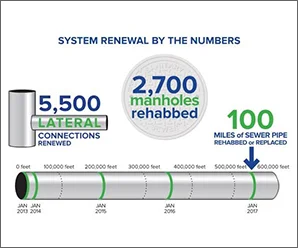Clean Water Nashville completed numerous projects in 2015 that upgraded Metro Nashville wastewater infrastructure.
Read MoreMetro Water Services is advancing plans for a major expansion of the Central Wastewater Treatment Plant (CWWTP). The plant was originally constructed in 1958 and has been expanded several times through the years to address environmental quality standards and to meet demands of Nashville's growth.
Read MoreThe majority of Nashville's sewer system lies hidden beneath streets and buried in easements. Since it cannot be readily observed, Metro Water Services (MWS) deploys a variety of technologies to assess the system's condition.
Read MoreNow in its sixth year, the Clean Water Nashville Program has achieved considerable advancement for both environmental compliance and overall system improvements across Davidson County.
Read MoreConstruction of a new, circular-shaped 260-foot diameter, 21 million gallon wet weather storage tank increases the capacity of wastewater storage during wet weather events. The new storage tank will be utilized when sewer flows exceed the capacity of the existing West Park Pump Station.
Read MoreThe Brick Church Pike Pipe Improvements project illustrates the sometimes demanding challenges that are encountered as Clean Water Nashville Overflow Abatement Program (CWNOAP) renews and enlarges Davidson County's sewer system.
Read MoreThe large-scale project, which began in January 2014, modernizes water and wastewater systems throughout residential and commercial areas in District 11.
Read MoreCured-in-place pipe (CIPP) lining is one of several sewer rehabilitation methods used to repair leaking or structurally unsound existing pipelines.
Read MoreMayor Megan Barry recently visited Clean Water Nashville's 28th Avenue Rehabilitation – Area 1 project site to learn more about how Nashville's aging sewer infrastructure is being renewed. As pictured, B.J. Kersteins of Insituform Technologies, Inc. (the construction contractor for this work) shows Mayor Barry a cured-in-place pipe liner. The pipe liner is inserted in the sewer to renew the system without excavating streets. Repairing sewers in this way extends the life of the system and addresses downstream overflows by reducing the amount of rainwater that infiltrates the system.
Read More









